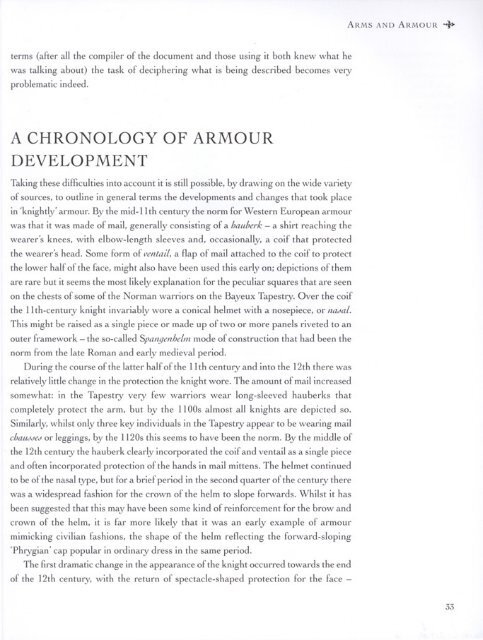Osprey - General Military - Knight - The Warrior and ... - Brego-weard
Osprey - General Military - Knight - The Warrior and ... - Brego-weard
Osprey - General Military - Knight - The Warrior and ... - Brego-weard
You also want an ePaper? Increase the reach of your titles
YUMPU automatically turns print PDFs into web optimized ePapers that Google loves.
terms (after all the compiler of the document <strong>and</strong> those using it both knew what he<br />
was talking about) the task of deciphering what is being described becomes very<br />
problematic indeed.<br />
A CHRONOLOGY OF ARMOUR<br />
DEVELOPMENT<br />
Taking these difficulties into account it is still possible, by drawing on the wide variety<br />
of sources, to outline in general terms the developments <strong>and</strong> changes that took place<br />
in 'knightly' armour. By the mid-11th century the norm for Western European armour<br />
was that it was made of mail, generally consisting of a hauberk — a shirt reaching the<br />
wearer's knees, with elbow-length sleeves <strong>and</strong>, occasionally, a coif that protected<br />
the wearer's head. Some form of ventail, a flap of mail attached to the coif to protect<br />
the lower half of the face, might also have been used this early on; depictions of them<br />
are rare but it seems the most likely explanation for the peculiar squares that are seen<br />
on the chests of some of the Norman warriors on the Bayeux Tapestry. Over the coif<br />
the 1 lth-century knight invariably wore a conical helmet with a nosepiece, or nasal.<br />
This might be raised as a single piece or made up of two or more panels riveted to an<br />
outer framework — the so-called Spangenhelm mode of construction that had been the<br />
norm from the late Roman <strong>and</strong> early medieval period.<br />
During the course of the latter half of the 11 th century <strong>and</strong> into the 12th there was<br />
relatively little change in the protection the knight wore. <strong>The</strong> amount of mail increased<br />
somewhat: in the Tapestry very few warriors wear long-sleeved hauberks that<br />
completely protect the arm, but by the 1100s almost all knights are depicted so.<br />
Similarly, whilst only three key individuals in the Tapestry appear to be wearing mail<br />
chaiuwj or leggings, by the 1120s this seems to have been the norm. By the mrddle of<br />
the 12th century the hauberk clearly incorporated the coif <strong>and</strong> ventail as a single piece<br />
<strong>and</strong> often incorporated protection of the h<strong>and</strong>s in mail mittens. <strong>The</strong> helmet continued<br />
to be of the nasal type, but for a brief period in the second quarter of the century there<br />
was a widespread fashion for the crown of the helm to slope forwards. Whilst it has<br />
been suggested that this may have been some kind of reinforcement for the brow <strong>and</strong><br />
crown of the helm, it is far more likely that it was an early example of armour<br />
mimicking civilian fashions, the shape of the helm reflecting the forward-sloping<br />
'Phrygian' cap popular in ordinary dress in the same period.<br />
<strong>The</strong> first dramatic change in the appearance of the knight occurred towards the end<br />
of the 12th century, with the return of spectacle-shaped protection for the face -<br />
ARMS AND ARMOUR •*}*•<br />
33







